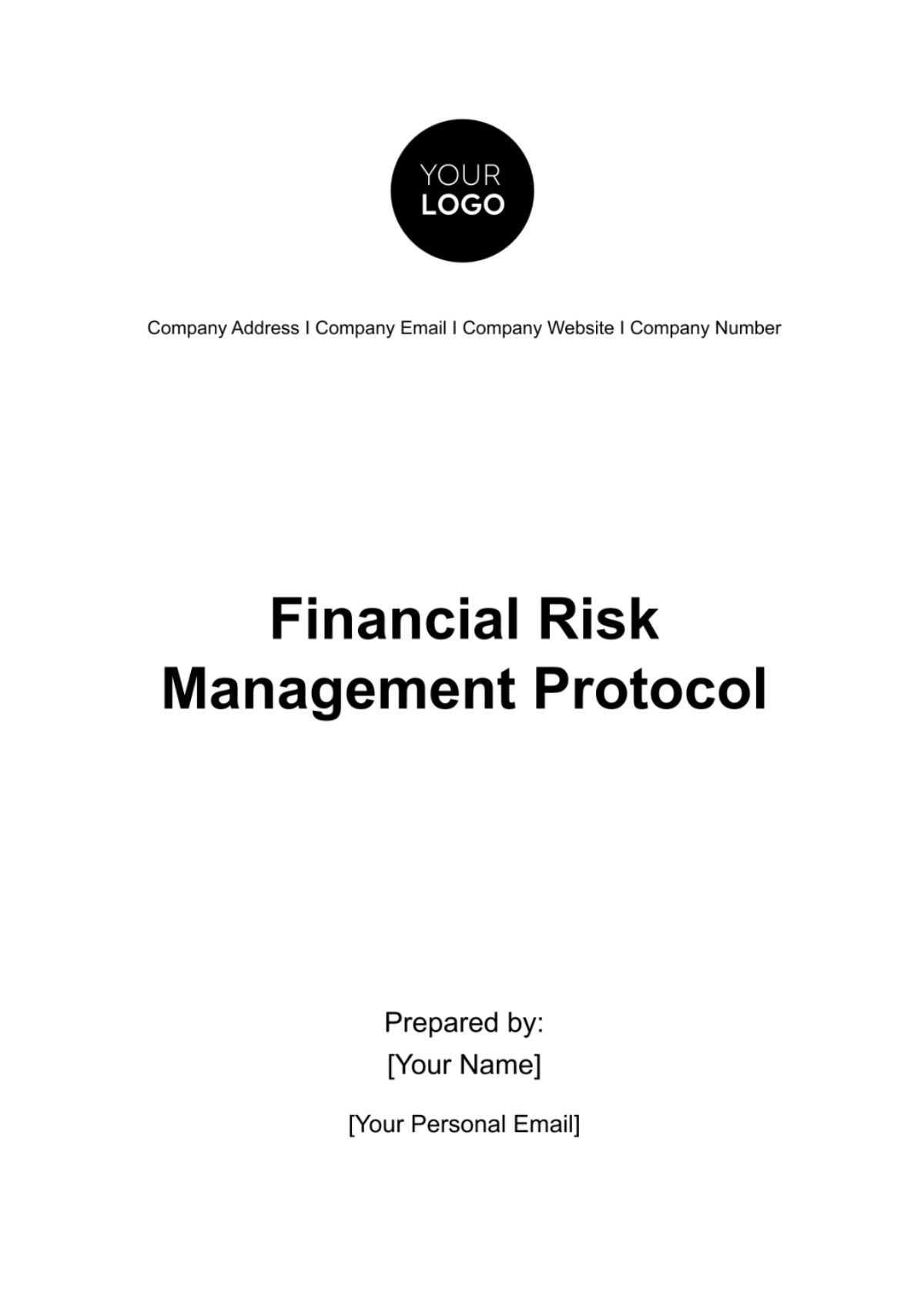Free Financial Risk Management Protocol

1. Introduction
In an often unpredictable world of business, financial risk is an inevitable aspect of operation. Recognizing this, [Your Company Name] has developed a comprehensive Financial Risk Management Protocol. This document serves as a cornerstone for managing financial risks, safeguarding the company's assets, and ensuring its ongoing viability and success.
Financial risks, ranging from market and credit risks to operational and liquidity challenges, can significantly impact a company's performance and reputation. Therefore, it is crucial for [Your Company Name] to have a robust framework in place to identify, assess, and mitigate these risks effectively. This protocol outlines systematic approaches and strategies to manage these risks, including risk avoidance, reduction, sharing, and retention. It also provides a structured process for risk assessment and measurement, ensuring that all potential financial threats are identified and quantified.
The implementation of this protocol is not just a compliance measure but a strategic imperative. It is designed to align with our business objectives and operational requirements, ensuring that risk management is an integral part of our decision-making process. By adhering to these guidelines, [Your Company Name] aims to enhance its financial resilience and adaptability, fostering a culture of prudent risk awareness and management across all levels of the organization.
This protocol is a living document, subject to regular reviews and updates to reflect the evolving financial landscape and the needs of our business. It is a testament to our commitment to financial integrity and sustainability, laying a foundation for long-term success and stability.
2. Scope
The Financial Risk Management Protocol of [Your Company Name] is meticulously designed to encompass a broad spectrum of financial activities and decisions that are fundamental to the company's operations. This inclusive scope ensures that the protocol is not just a theoretical framework but a practical guide that is deeply embedded in the day-to-day financial workings of the company.
Specifically, this protocol applies to:
Investments: It covers the strategies, processes, and decisions related to the company’s investments. This includes, but is not limited to, the selection of investment avenues, allocation of resources, and management of investment risks.
Expenditures: The protocol provides guidance on managing the company's expenses. It ensures that spending is aligned with the company’s financial goals and risk appetite, and that there are controls in place to prevent budget overruns and unwarranted financial exposures.
Revenue Management: This aspect of the protocol deals with how the company manages and safeguards its income streams. It encompasses strategies for revenue growth, risk assessment in new business ventures, and protection against revenue-related risks such as customer default or market fluctuations.
Risk Mitigation Strategies: Central to the protocol is the detailed approach to mitigating various financial risks. This involves identifying potential risks, assessing their impact, and implementing appropriate strategies to manage or mitigate these risks.
The scope of this protocol is deliberately comprehensive to ensure that all aspects of [Your Company Name]'s financial health are considered and protected. By applying this protocol to a wide range of financial activities, the company can safeguard its assets, optimize its financial performance, and achieve its strategic objectives in a risk-aware manner. This holistic approach is essential in today’s complex and fast-paced business environment, where financial risks can arise from multiple and sometimes unexpected sources.
3. Risk Identification
The identification of financial risks is a critical step in the risk management process for [Your Company Name]. This chapter outlines the primary categories of risks that the company may face, along with specific risk factors under each category. Each risk factor is accompanied by a description and suggested mitigation strategies, providing a comprehensive approach to risk management.
3.1 Market Risk
Market Risk refers to the potential losses that [Your Company Name] might face due to fluctuations in the financial market. This section details the various factors contributing to market risk and proposes strategies to mitigate them.
Risk Factor | Description | Mitigation Strategy |
|---|---|---|
Currency Fluctuations | Risk due to changes in currency value | Use of hedging and currency derivatives |
Interest Rate Changes | Impact on loans and investments | Fixed-rate borrowing and interest swaps |
Commodity Price Changes | Fluctuations in commodity prices | Diversifying suppliers and forward contracts |
3.2 Credit Risk
Credit Risk is the risk of loss resulting from a customer's or counterparty's inability to fulfill their financial obligations. This subsection addresses the key aspects of credit risk.
Risk Factor | Description | Mitigation Strategy |
|---|---|---|
Customer Default | Risk of non-payment by customers | Credit checks and insurance |
Bankruptcy | Counterparty becoming insolvent | Diversifying client portfolio |
3.3 Operational Risk
Operational Risk involves risks arising from internal processes, people, and systems. This segment outlines the common operational risks and their mitigation.
Risk Factor | Description | Mitigation Strategy |
|---|---|---|
Fraud and Embezzlement | Internal financial misconduct | Internal audits and fraud detection systems |
System Failures | IT system breakdowns | Regular system maintenance and backups |
3.4 Liquidity Risk
Liquidity Risk is the risk of [Your Company Name] being unable to meet its short-term financial obligations. This part focuses on the identification and management of liquidity-related risks.
Risk Factor | Description | Mitigation Strategy |
|---|---|---|
Cash Flow Shortages | Inability to meet short-term obligations | Maintaining liquid reserves |
Market Downturn | Access to funds during market stress | Diverse investment portfolio |
Through this detailed risk identification process, [Your Company Name] aims to establish a strong foundation for effective risk management, ensuring that all potential financial threats are recognized and addressed proactively.
4. Risk Assessment and Measurement
The process of risk assessment and measurement in [Your Company Name] is a critical component in understanding and managing the various financial risks we face. This section outlines the methodologies employed in both quantifying and qualitatively evaluating risks.
Quantitative Analysis
Quantitative analysis involves the use of financial models to numerically quantify the risk exposure of [Your Company Name]. This approach allows for a data-driven understanding of risks, enabling the company to:
Measure Probability and Impact: Apply statistical models to estimate the likelihood and potential impact of various financial risks.
Scenario Analysis: Perform stress testing and scenario analysis to understand the effects of different risk factors under various conditions.
Risk-Adjusted Performance Metrics: Use metrics such as Value at Risk (VaR) and Expected Shortfall to gauge potential losses in adverse scenarios.
Qualitative Analysis
While quantitative methods are crucial, not all risks can be numerically quantified. Qualitative analysis is therefore employed to evaluate these non-quantifiable risks. This involves:
Expert Judgment: Leveraging the insights and experience of financial experts to assess risks that are not easily quantifiable.
Market Analysis: Keeping abreast of market trends and developments that might impact the company's financial health.
Risk Awareness Culture: Fostering a culture where staff at all levels are encouraged to identify and communicate potential risks.
Risk Reporting
Effective risk management in [Your Company Name] also hinges on timely and accurate risk reporting. This involves:
Regular Updates: Providing ongoing updates on risk metrics and exposures to the management team.
Dashboard and Reporting Tools: Utilizing risk management software and tools for real-time monitoring and reporting.
Management Reviews: Regular reviews by the management team to assess the effectiveness of risk management strategies and make necessary adjustments.
This comprehensive approach to risk assessment and measurement ensures that [Your Company Name] not only identifies and quantifies risks but also maintains a constant vigilance over the evolving risk landscape, thereby safeguarding the company's financial stability.
5. Risk Management Strategies
The Risk Management Strategies chapter is an essential part of the Financial Risk Management Protocol at [Your Company Name]. It outlines the approaches and tactics the company employs to manage and mitigate financial risks. This chapter is divided into four key strategies: Risk Avoidance, Risk Reduction, Risk Sharing, and Risk Retention.
5.1 Risk Avoidance
Risk Avoidance involves steering clear of activities that could expose [Your Company Name] to significant financial risks. This strategy includes:
Avoiding High-Risk Investments and Markets: Carefully evaluating investment opportunities and avoiding those with an unacceptable level of risk.
Prudent Decision-Making: Making conservative decisions in financial matters to minimize exposure to potential financial crises.
5.2 Risk Reduction
Risk Reduction is about minimizing the potential impact of financial risks. This strategy is implemented through:
Diversifying Investments and Revenue Streams: Spreading out investments and revenue sources to reduce the impact of any single failing asset or market.
Implementing Strong Internal Controls: Establishing robust internal processes and controls to prevent financial mismanagement and fraud.
5.3 Risk Sharing
Risk Sharing involves spreading the financial risks across different parties. This is achieved through:
Insurance Policies: Purchasing insurance to transfer the financial burden of certain risks to an insurance provider.
Partnerships: Engaging in partnerships or alliances that allow for the distribution of risk among multiple entities.
5.4 Risk Retention
Risk Retention is the acceptance of certain risks as an inherent part of doing business. This includes:
Accepting Certain Risks: Recognizing that some level of risk is unavoidable and can be an integral part of strategic business decisions.
Allocating Funds for Potential Losses: Setting aside reserves or contingency funds to cover potential financial losses due to these risks.
By employing these strategies, [Your Company Name] aims to effectively manage its financial risks, ensuring a stable and sustainable financial future. Each strategy is applied in accordance with the company's overall risk appetite and business objectives, creating a balanced and dynamic approach to risk management.
6. Implementation and Monitoring
The Implementation and Monitoring chapter is crucial in the Financial Risk Management Protocol of [Your Company Name]. It ensures that the risk management strategies outlined in the document are not only implemented effectively but are also continuously monitored and updated as necessary. This chapter is structured into three main components: Training, Monitoring, and Review.
Training
Training is a key element in ensuring that employees at all levels of [Your Company Name] are equipped with the knowledge and skills necessary to identify and manage financial risks effectively. This involves:
Regular Training Programs: Conducting workshops and training sessions to educate employees about risk management practices and their role in these processes.
Updated Training Materials: Keeping training materials current with the latest risk management techniques and regulatory changes.
Engaging External Experts: Where necessary, bringing in external experts to provide specialized training on complex risk management topics.
Monitoring
Continuous monitoring is essential to the successful implementation of risk management strategies. It includes:
Ongoing Oversight of Financial Activities: Regular monitoring of financial transactions and activities to detect any deviations from the expected risk profile.
Utilization of Monitoring Tools: Implementing advanced software and tools for real-time monitoring of various financial metrics and indicators.
Employee Involvement: Encouraging employees to be vigilant and report any unusual activities or potential risks they identify.
Review
Regular reviews and updates to the risk management protocol ensure that [Your Company Name]'s approach to risk management remains effective and relevant. This includes:
Periodic Protocol Reviews: Conducting scheduled reviews of the risk management protocol to ensure it aligns with the current financial environment and business objectives.
Incorporating Feedback: Taking into account feedback from employees and stakeholders to improve and refine the risk management processes.
Updating Strategies: Modifying and updating strategies and procedures in response to new risks, business changes, or regulatory requirements.
Through effective implementation and diligent monitoring, [Your Company Name] aims to maintain a robust risk management framework that is dynamic and responsive to the evolving financial landscape, thereby securing the company's assets and ensuring its long-term financial health.
7. Reporting and Communication
In the context of the Financial Risk Management Protocol at [Your Company Name], the Reporting and Communication chapter is pivotal. It delineates the protocols and procedures for disseminating information related to financial risks, both within the organization and to external stakeholders. This chapter is divided into two main sections: Internal Reporting and External Communication.
Internal Reporting
Internal reporting is a critical component for effective risk management. It involves:
Regular Financial Risk Reports: Periodic preparation and submission of detailed reports on financial risk to the management. These reports include assessments of current risks, mitigation measures taken, and any potential risks on the horizon.
Accessible Reporting Formats: Utilizing clear and accessible formats for reporting to ensure that information is easily understandable and actionable.
Data-Driven Insights: Providing data-driven insights to support strategic decision-making within the company.
The goal of internal reporting is to ensure that the company's leadership is always informed about the current risk landscape and can make informed decisions.
External Communication
Transparent communication with external stakeholders is equally crucial. This section includes:
Regular Updates to Stakeholders: Keeping shareholders, investors, and relevant external parties informed about the company's risk management activities and financial health.
Transparency: Ensuring that communication is transparent, reflecting both the challenges and the measures taken to address financial risks.
Regulatory Compliance: Meeting all regulatory requirements for external reporting and disclosure related to financial risks.
This external communication is designed to maintain trust and confidence among stakeholders, ensuring they are aware of [Your Company Name]'s commitment to proactive financial risk management.
Through robust reporting and open communication, [Your Company Name] aims to foster a culture of transparency and informed decision-making, which is essential for effective financial risk management and long-term business sustainability.
8. Policy Review and Update
The Financial Risk Management Protocol at [Your Company Name] is not a static document; it requires regular evaluation and updates to remain effective and relevant. The Policy Review and Update chapter details the procedures and responsibilities for maintaining the currency and effectiveness of the risk management protocol.
Frequency of Review
Annual Reviews: The protocol will undergo a comprehensive review annually. This ensures that any changes in the financial landscape, business operations, or regulatory environment are reflected in our risk management strategies.
Ad-Hoc Updates: In addition to the scheduled annual reviews, the protocol will be subject to ad-hoc updates as needed. This is particularly important in response to significant changes in the market, operational shifts, or after a major risk event.
Responsibilities
Designated Responsible Party: The primary responsibility for the review and update of this protocol lies with [Your Name], holding the position of [Position at Company]. This individual will ensure that the protocol is consistently aligned with the company’s objectives and risk appetite.
Collaborative Review Process: While [Your Name] is responsible for initiating the review, it is a collaborative process. It involves input and feedback from various departments within [Your Company Name], including finance, operations, and compliance.
Engagement with External Experts: If necessary, external experts or consultants may be engaged to provide insights or guidance during the review process, ensuring that the protocol adheres to industry best practices and regulatory requirements.
Documentation and Approval
Documentation of Changes: All revisions and updates to the protocol will be thoroughly documented, highlighting the reasons for the changes and the expected impact on the company’s risk management approach.
Approval Process: Revised versions of the protocol will undergo a formal approval process, including review by senior management and, where applicable, the board of directors.
Through this structured approach to policy review and updating, [Your Company Name] ensures that its Financial Risk Management Protocol remains a living document, evolving in tandem with the business and the external environment. This commitment to regular review and proactive updates is key to maintaining the effectiveness of our financial risk management strategy, safeguarding the company’s assets, and supporting its long-term strategic goals.
9. Contact Information
The Contact Information chapter provides essential details for establishing communication with [Your Company Name]. This section is intended to offer a quick reference for internal and external stakeholders, including employees, partners, and clients, ensuring easy access to the company's primary contact channels. Below are the key contact details for [Your Company Name]:
Company Name: [Your Company Name]
Address: [Your Company Address]
Phone: [Your Company Phone Number]
Email: [Your Company Email]
Website: [Your Company Website]
Social Media: [Your Social Media]
10. Appendix
Related Documents: Financial reports, market analysis, etc.
Relevant Legislation: Information on applicable financial regulations.
- 100% Customizable, free editor
- Access 1 Million+ Templates, photo’s & graphics
- Download or share as a template
- Click and replace photos, graphics, text, backgrounds
- Resize, crop, AI write & more
- Access advanced editor
Template.net offers a cutting-edge solution for financial professionals with our editable Financial Risk Management Protocol Template. Streamline your risk management processes with this comprehensive document. Tailor it to your company's needs and ensure compliance with our AI editor tool for easy customization. Safeguard your financial future with ease using this invaluable template. Don't miss out on the opportunity to mitigate risks effectively.





























